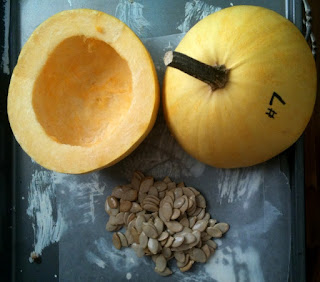Here's a comparison of the flesh color and thickness. The lighting wasn't very good so they all look a little bleached out. Note the thick flesh, I'd mentioned on number 6.
My favorite overall is number 1. Stark white skin (which came from 'White Scallop' squash) and yellowish flesh. High count of plump little hulless seeds.
Number 5 looks a lot like the 'Styrian Hulless' ancestor. It also has a serious flaw. The seeds have a strong tendency to sprout while still inside the pumpkin. This is something I've been selecting against, so I'll most likely never plant any seeds from this one.
Number 6 with its interesting thick flesh. I should've known by how heavy this guy was! This is a trait I'd like to keep in the population. So since it also has a high number of plump seeds, I'll probably use this one in the future plantings.
Number 7 was another dud - with shells on the seeds.
When all the seeds were safely drying back down in the basement. I put 1, 2 and 3 in the oven and baked them for almost 2 hours. Then I scooped out the flesh and processed it in the food processor.
I put 8 cups in the freezer (2 cup portions in each sandwich bag) to freeze and still had enough puree to be the base for two loaves of squash bread.
I don't generally follow any recipe anymore when I make bread, but this is essentially just white bread made with pumpkin puree in place of the water.














The thick-walled pumpkin reminds me of what a melon looks like in cross-section.
ReplyDeleteThe trait would be handy to the folks raising giant pumpkins. One common problem they have is the squash sometimes buckle inwards as they expand, because the walls are too thin relative to the overall diameter.
That's exactly what I thought when I first saw the opened squash - it reminded me of a cantaloupe too.
ReplyDeleteAnd that's a great idea, to use the thicker walls to strengthen giant pumpkins. Another side benefit might be the increased weight for a relatively smaller circumference. And you've got me thinking... I wonder if the "Hr" (hard rind) trait would be beneficial to those giant pumpkin breeders too? A highly lignified rind could possibly prevent buckling inward too.
If the hard-rind developed during growth, I would think it would impair overall growth.
ReplyDeleteI also just realized the giant pumpkins are C. maxima, while your pumpkins are C. pepo. Supposedly the two species can cross, but with some difficulty. I think it would be a fun experiment, if I had room to grow giant pumpkins of any sort.